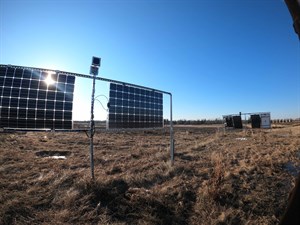Time-Lapse Series Showcases Vertical Bifacial Solar Panels

A new time-lapse series taken at the Solar Test Site on the UAF campus shows how the sun interacts with vertical bifacial solar panels during Alaska’s long spring and summer daylight hours.
These panels, which can absorb and convert sunlight into electricity on two sides instead of one, are mounted vertically along a north-south axis, with their sides facing east and west.
As the sun rises in the morning and illuminates one side of the vertical bifacial panels, there is an initial production spike. A second spike in production follows in the afternoon when the other side is illuminated. This production profile is different from the output of a traditional south-facing monofacial panel.
The overall production from bifacial panels is greater than from monofacial panels, an effect which is amplified at higher latitudes and is also enhanced by reflection from snow cover. This is one example of some of the unique opportunities for solar photovoltaic power in Alaska.
The Solar Test Site is part of ACEP’s Solar Technologies Program, which is working to responsibly increase the use of solar PV in Alaska and the Arctic where it is technically and economically warranted.
The test site was built in partnership with Sandia National Laboratories, with additional support from the Office of Naval Research.
For more information on the test site and Solar Technologies Program, contact Erin Whitney at erin.whitney@alaska.edu or visit the Solar Technologies Program website.
The sun illuminates an east facing solar panel as seen from the west side. Photo by Amanda Byrd.


